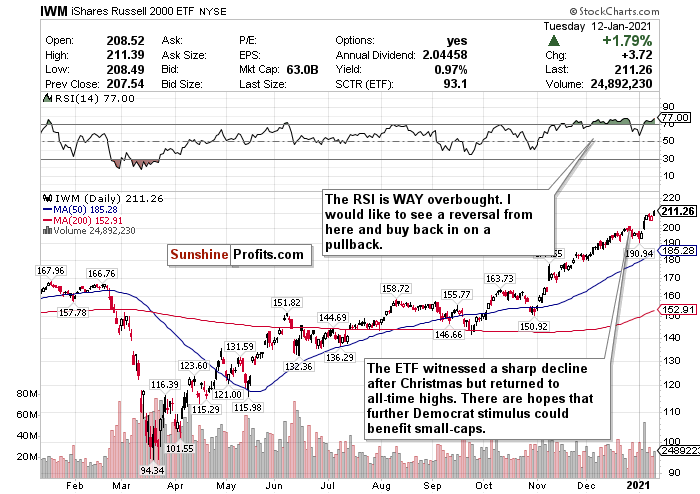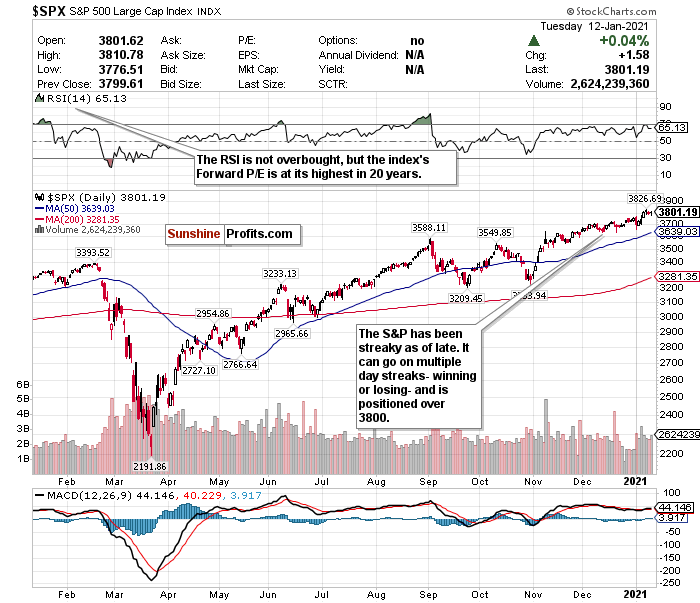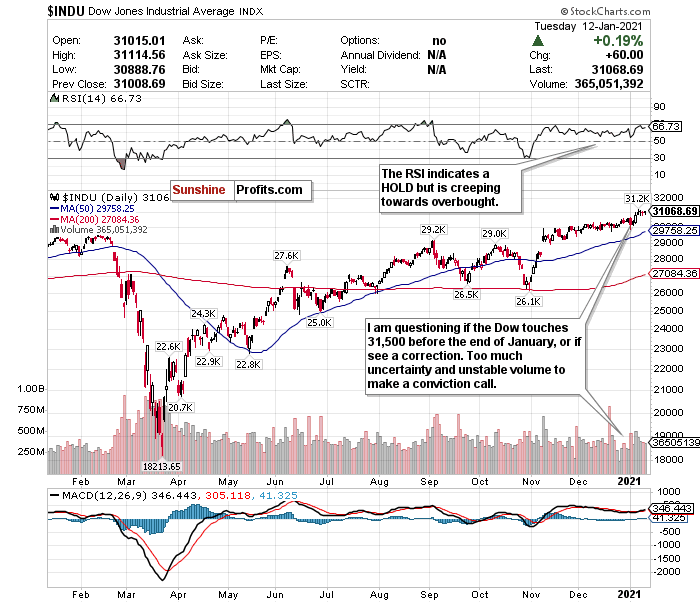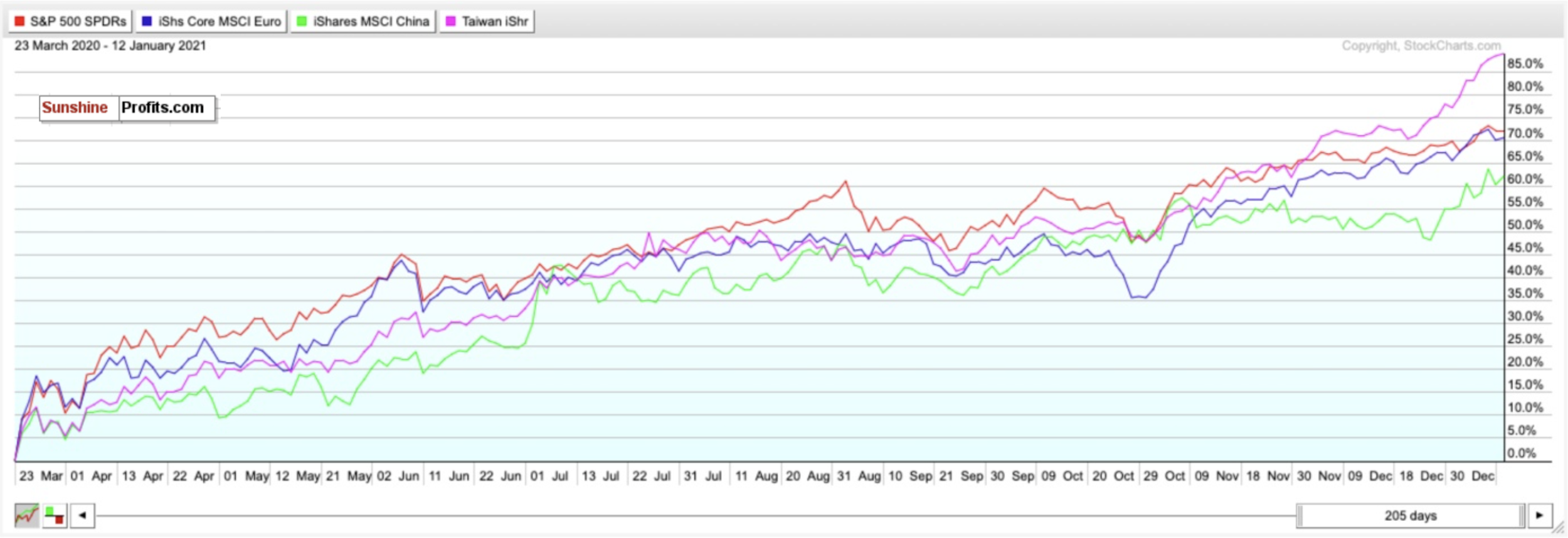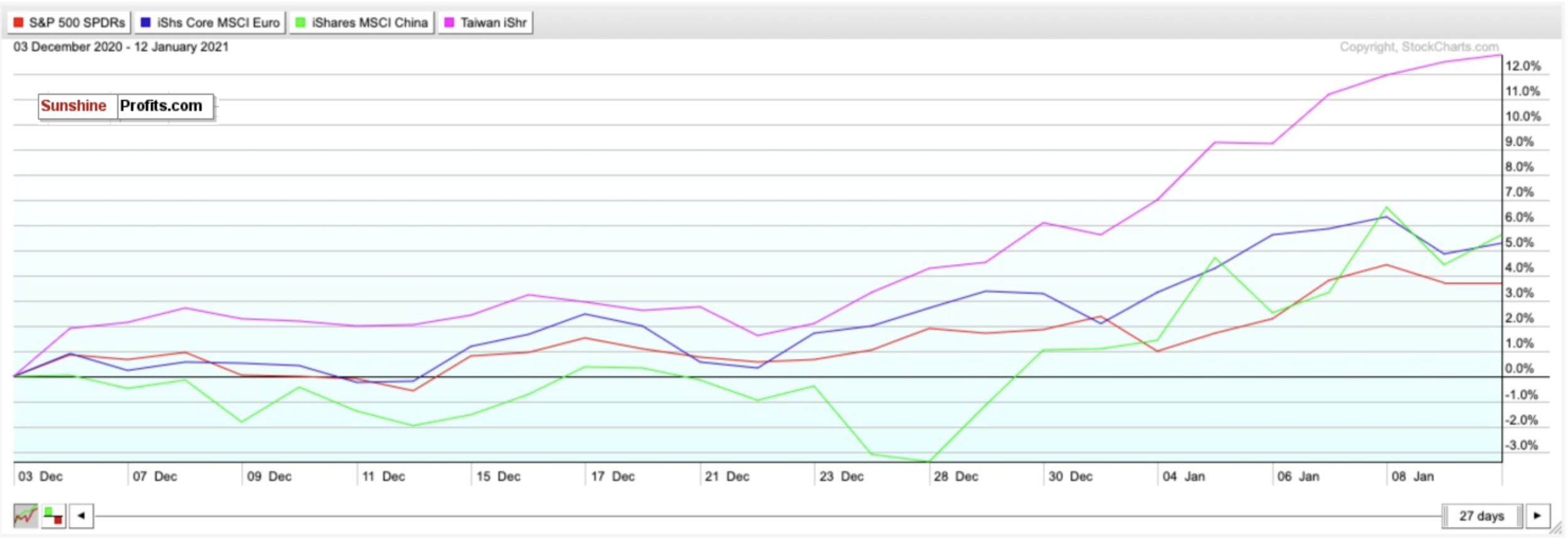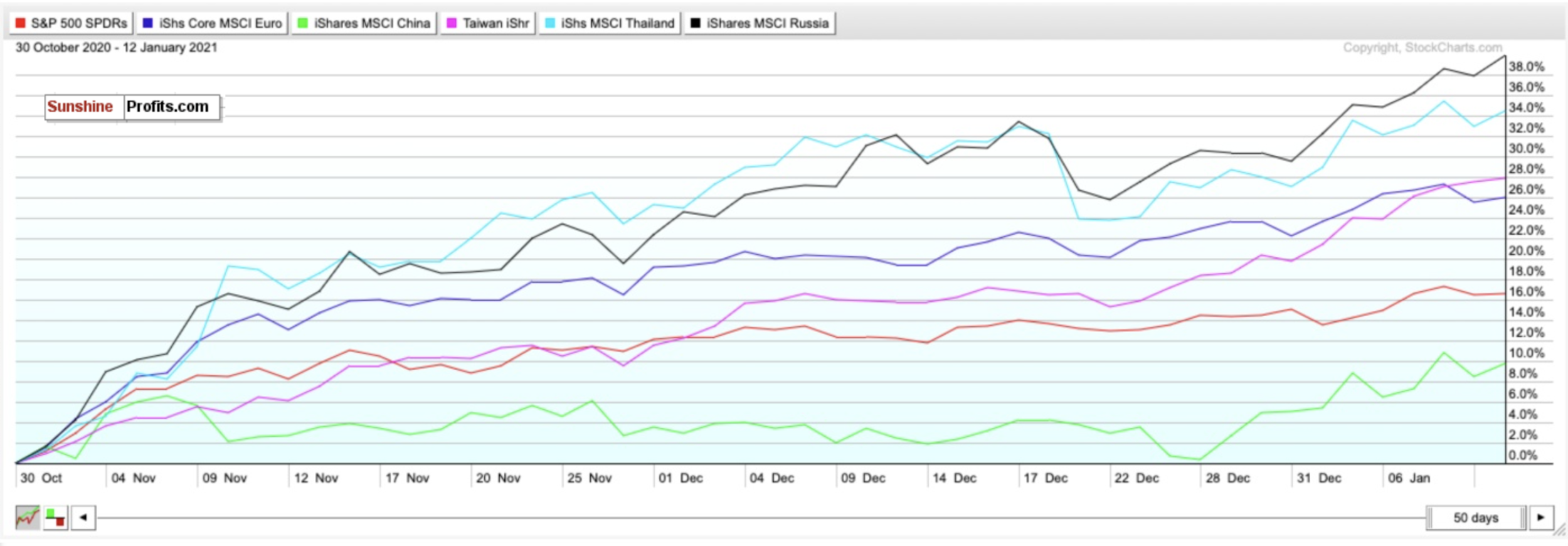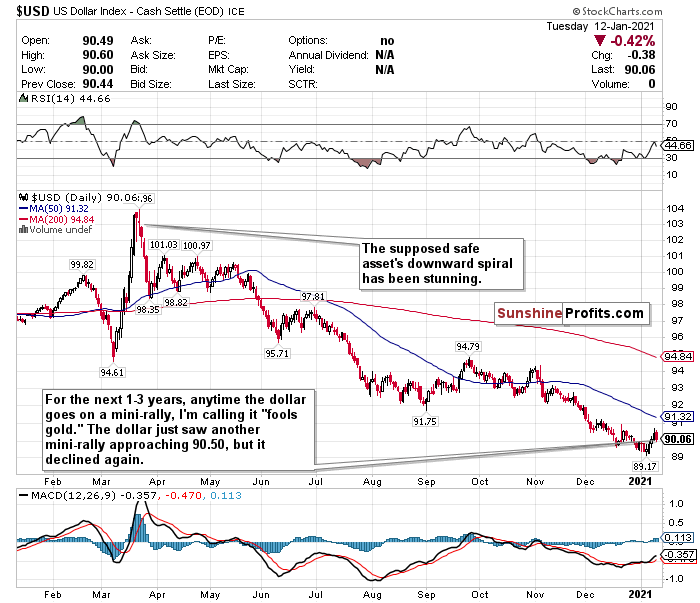Have you ever had a stock that's so far in the green that you’d never sell it? Rolling with “House Money?”
My goal for these updates is to educate you, give you ideas, and help you manage money like I did when I was pressing the buy and sell buttons for $600+ million in assets. I left that career to pursue one where I could help people who needed help, instead of the ultra-high net worth. Hopefully, you’ll find the below enlightening from my perspective, and I welcome your thoughts and questions.
We are now firmly in the second week of 2021. After markets declined to start the week, we saw a muted recovery on Tuesday (Jan. 12).
With Democrats gaining full control of both the legislative and executive branches of the government, the prospect of further stimulus has sent stocks soaring to their highest valuations in years. However, the short-term tug of war between good news and bad news will continue.
I am especially concerned about overstretched valuations for stocks combined with the return of inflation.
The S&P 500 is trading at its highest forward P/E ratio since 2000, and the 10-year treasury is at its highest level since March. Overvalued stocks combined with inflation returning by mid-year is quite concerning for me. I feel that a correction between now and the end of Q1 2020 is likely.
According to Goldman Sachs’ Chief Economist Jan Hatzius, U.S. stocks and bond markets could possibly “take more of a breather” in the near term. National Securities’ chief market strategist Art Hogan also believes that we could see a 5%-8% pullback by the end of this month.
Generally, corrections are healthy, good for markets, and more common than most realize. Only twice in the last 38 years have we had years WITHOUT a correction (1995 and 2017). Because we haven’t seen a correction since March 2020, we could be well overdue.
This is healthy market behavior and could be a very good buying opportunity for what should be a great second half of the year.
While there will certainly be short-term bumps in the road, I love the outlook in the mid-term and long-term once the growing pains of rolling out vaccines stabilize.
The consensus is that 2021 could be a strong year for stocks. According to a CNBC survey which polled more than 100 chief investment officers and portfolio managers, two-thirds of respondents said the Dow Jones will most likely finish 2021 at 35,000, while five percent also said that the index could climb to 40,000.
Therefore, to sum it up:
While there is long-term optimism, there are short-term concerns. A short-term correction between now and Q1 2021 is very possible. I don’t think that a correction above ~20% leading to a bear market will happen.
House money is fun to play with, but trust me - you won’t feel as well if you let it ride through a full correction without taking profits.
Best of luck, and happy trading!
Can Small-caps Own 2021?
Figure 1- iShares Russell 2000 ETF (IWM)
Small-caps continue to surge and recover from their brief downturn after Christmas.
Although I believed initially that the Russell 2000’s record-setting run since the start of November was coming to an end, the iShares Russell 2000 ETF (IWM) has rallied 9.18% since January 4th.
Small-cap stocks appear to be the most excited from the Democrat sweep in Georgia due to hopes of further economic stimulus.
While I love small-cap stocks in the long-term, especially as the world reopens, the index has overheated by any measurement. Before January 4th, the RSI for the IWM Russell 2000 ETF was at an astronomical 74.54. I called a pullback happening in the short-term due to this RSI, and it happened. Well now the RSI is at a scorching hot 77. I feel that these stocks should imminently cool down in the near-term.
Stocks simply don’t always go up in a straight line, and that’s what the Russell 2000 did between November and Christmas. It’s looked eerily similar since January 4.
What this also comes down to, is that small-caps are more sensitive to the news- good or bad. I think that vaccine gains have possibly been baked in by now. There could be another near-term pop due to further stimulus hopes, but it’s likely that small-caps in the near-term could trade sideways before an eventual larger pullback.
I hope small-caps decline a minimum of 10% before jumping back in for long-term buying opportunities.
SELL and take profits if you can- but do not fully exit positions.
If there is a pullback, this is a STRONG BUY for the long-term recovery.
S&P 500’s Valuation is its Highest in Years
Figure 2- S&P 500 Large Cap Index $SPX
After briefly testing an overbought RSI to start the week, the S&P is now sitting at a somewhat healthier 65.13. However, the S&P 500′s forward P/E ratio is currently sitting around 22.7- its highest level since 2000.
The S&P 500 has been trading as a streaky index as of late and reflects the broader tug-of-war between good and bad news. The large-cap, blue-chip index, seemingly goes on multiple day winning streaks and losing streaks on a weekly basis. After seeing its worst sell-off since October last Monday (Jan. 4), for example, it went on a four-day win streak and broke past 3800.
I always cheer stocks going up and hitting records, but I also want buying opportunities. I would like to see this blue-chip large-cap index drop to around 3600 or below before making a BUY call for the long-term.
For now, my near-term outlook is murky. A short-term correction could inevitably occur by the end of Q1 2021, but for now, I am switching my call back to a HOLD. If the RSI ticks up again, I will change it back to SELL.
While many analysts and strategists believe this short-term uncertainty is worth it for long-term potential, (and I tend to agree), I maintain that for now the index is in danger of overheating. I would like to see a sharp correction before initiating S&P exposure at a discount. There is clear upside for the second half of 2021. I would just prefer to maximize the upside if it’s possible to buy the ETF at a lower level.
For an ETF that attempts to directly correlate with the performance of the S&P, the SPDR S&P ETF (SPY) is a good option.
Does the Dow Approach 31,500 or 29,500 Before the End of January?
Figure 3- Dow Jones Industrial Average $INDU
There have been irrational and overly excited moves higher to kick off the new year. However, I am not seeing that quite as much with the Dow Jones index.
Whenever I seemingly question if the Dow has more room to run towards record highs, it hits them. It defies logic, frankly. If the Dow can touch all-time highs the same day that hooligans invade the Capitol, then what can stop the index?
Be that as it may, I still have many short-term questions for the Dow Jones, and believe it is just as likely to touch 29,500 as it is 31,500 before the end of month. After trading as low as around 29,650 at one point before the new year (Dec. 21), the Dow has remained firmly above 30,000 for weeks and is now above 31,000.
Yet despite some long-term optimism, for now, my short-term questions take precedence. I don’t like how COVID-19 is trending (who does?), I am disappointed in the vaccine roll-out, and I am concerned about short-term economic and political headwinds.
While a 35,000 call to close out 2021 is a bit aggressive, I think that the second half of 2021 could show robust gains for the index.
With so much uncertainty and the RSI creeping towards overbought, the call on the Dow stays a HOLD. I am closely monitoring the RSI in the event that it exceeds 70.
This is a very challenging time to make a call on the Dow with conviction. But one thing I foresee is that if and when there is a drop in the index, it will not be strong and sharply relative to the gains since March 2020. It is more likely than not that we will be in a sideways holding pattern until vaccines are available to the general public by mid-2021.
For an ETF that attempts to directly correlate with the performance of the Dow, the SPDR Dow Jones ETF (DIA) is a strong option.
Mid-Term/Long-Term
Taiwan and Others for Emerging Market Exposure - Not China
Figure 4- SPY, IEUR, MCHI, and EWT comparison chart-March 23, 2020-Present
Although I am quite excited about emerging markets in both the medium-term and long-term, it is country-specific.
China garners most of the attention as a so-called “emerging market.” But it is truly hard to consider it an emerging market any longer and has not been a top performer since markets bottomed on March 23rd.
The country is also not a top option for 2021 for international exposure. While China’s regional upside is undeniable, it also has geopolitical risks- and has had its economic recovery baked-in.
Look at the Taiwan iShares ETF (EWT) as an alternative. Taiwan has outperformed China in the short-term, medium-term, and long-term.
As seen in the chart below, ever since I first called the Taiwan ETF (IWT) a BUY on December 3rd it has outperformed the MSCI China ETF (MCHI), the SPDR S&P ETF (SPY), and iShares Core Europe ETF (IEUR).
The EWT has gained 12.78%- more than doubling the MSCI China ETF’s (MCHI) returns. The Taiwan ETF has also outperformed the SPY S&P 500 ETF and the IEUR ETF which tracks Europe.
Figure 5- SPY, IEUR, MCHI, and EWT comparison chart- Dec. 3, 2020-Present
China may have handled the pandemic better than other countries and continues to demonstrate its ability to handle COVID-19’s economic shocks. But keep in mind that this is a regional victory, not just China.
There are two other emerging markets I am very bullish on for 2021 as well- Thailand and Russia. According to a Bloomberg study from December 16th based on 11 indicators of economic and financial performance, Thailand topped the list due to solid reserves and a high potential for portfolio inflows, while Russia scored second due to robust external accounts, a strong fiscal profile, and an undervalued currency.
Do you know who scored last on this list? China. High expectations were largely already baked in during its 2020 recovery, and there is no longer upside.
Do you also know who significantly outperformed the Taiwan ETF (IWT), the MSCI China ETF (MCHI), the SPDR S&P ETF (SPY), and iShares Core Europe ETF (IEUR) since October 30th? The iShares MSCI Thailand ETF (THD) and the iShares MSCI Russia ETF (ERUS).
Figure 6- SPY, IEUR, MCHI, EWT, THD, ERUS comparison chart- Oct. 30, 2020-Present
For broad exposure to Emerging Markets, you will want to BUY the iShares MSCI Emerging Index Fund (EEM), for exposure to a regional economic power without the geopolitical risks of China, you will want to BUY the iShares MSCI Taiwan ETF (EWT). Consider the iShares MSCI Thailand ETF (THD) and the iShares MSCI Russia ETF (ERUS) as well for 2021 upside.
The Dollar Saw Another Rally - Predictably, it Stalled
Figure 7- U.S. Dollar $USD
Although the U.S. Dollar ticked up somewhat last week (and the start of this week), I did not and still do not have faith in the greenback as a safe asset.
I’m still calling out the dollar’s weakness after several weeks and expect the decline to restart thanks to a dovish Fed and multiple headwinds.
Any time the U.S. Dollar rallies, I am calling it “fool’s gold.” Since I started doing these newsletters about a month ago, I have consistently said that any minor rally the dollar experienced would be a mirage. Since it briefly pierced the 91-level on December 9th, it has fallen nearly 1.12%. Despite experiencing another mini-rally and nearly piercing the 91-level again on December 22, I remained steadfast in my bearish outlook of the dollar. Since the open on December 23rd, the U.S. Dollar has declined nearly another 0.53%.
It has also declined another 0.42% since the start of the week.
Although the dollar is back above the 90-level, I don’t think it will last.
Since hitting a nearly 3-year high on March 20th, the dollar has plunged nearly 13% while emerging markets, foreign currencies, precious metals, and cryptocurrencies continue to strengthen. Gold for example reached an 8-week high on Tuesday (Jan. 5), and Bitcoin continues to hit all-time highs.
On days when COVID-19 fears outweigh any other positive sentiments, dollar exposure might be good to have since it is a safe haven. But in my view, you can do a whole lot better than the US dollar for safety.
I have too many doubts on the effect of interest rates this low for this long, government stimulus, strengthening of emerging markets, and inflation to be remotely bullish on the dollar’s prospects over the next 1-3 years. Meanwhile, the US has $27 trillion of debt, and it’s not going down anytime soon.
Another headwind to consider for the dollar is Democrat control of the government. Because Democrats now have control over both the executive and legislative branches of the government, more aggressive stimulus could be imminent bringing further devaluation of the dollar.
Additionally, according to The Sevens Report, if the dollar falls below 89.13, this could potentially raise the prospect of a further 10.5% decline to the next support level of 79.78 reached in April 2014. Despite the dollar’s rally this week, I believe we are closer to this point than most realize.
Where possible, HEDGE OR SELL USD exposure.
Pay Very Close Attention to Inflation
Pay very close attention to the possible return of inflation within the next 6-12 months. The Fed has said it will allow the GDP to heat up, and it may overshoot in the medium-term as a result. GDP growth may falter in Q1 2021 but pay close attention to what happens in Q2 and Q3 once vaccines begin to be rolled out on a massive scale. It is only inevitable that inflation will return with the Fed’s policy and projected economic recovery by mid-2021.
The 10-year’s recent rally reflects this as well.
If you are looking to the future to hedge against inflation, look into TIPS, commodities, gold, and potentially some REITs.
In the mid-term, I have BUY calls on the SPDR TIPS ETF (SPIP), the Invesco Optimum Yield Diversified Commodity Strategy No K-1 ETF (PDBC), the SPDR Gold Shares ETF (GLD), and the iShares Cohen & Steers REIT ETF (ICF).
Long-Term
There is so much to worry about in the short-term. But I’m convinced that economic stimulus and the progress made with the vaccine(s) bodes well for the second half of 2021. We may be at the beginning of the end of the pandemic-but over the next 1-3 months, this could be a very bumpy ride back.
There does seem to be one consensus though: 2021 could be a big year for stocks.
I have a very good feeling about stocks, especially small-caps, value stocks, and cyclicals. I just have a much better feeling for them in the second half of 2021. I almost hope we see a correction within the first 3 months of 2021. This could be a very strong buying opportunity.
Summary
The current headwinds are very concerning. Nobody likes living through a pandemic, and nobody likes seeing their Capitol Building ransacked by thugs. Last week was quite the week to start off the new year, and this week is not even half over yet.
With that being said, I am optimistic for the second half of 2021 despite the bumpy path there. Until COVID-19 is eradicated, there will inevitably be a tug of war between optimism and pessimism.
A short-term correction to start 2021 is inevitable-but do not let this scare you. Remember- corrections are NORMAL and markets tend to look 6-12 months down the road. Although it is very plausible that there could be some short-term uncertainty and volatility, use this as a time to find buying opportunities for the second half of 2021. Do not get caught up in fear if there is a correction.
I doubt that a crash like the one we saw in March is on the horizon, but a pullback of some sort is coming. Do not be fearful though. Since markets bottomed on March 23rd, here are how the ETFs tracking the indices have performed: Russell 2000 (IWM) up 114.49%. Nasdaq (QQQ) up 85.08%. S&P 500 (SPY) up 72.05%. Dow Jones (DIA) up 69.15%.
In the long-term, markets always end up moving higher and are focused on the future rather than the present.
To sum up all our calls, in the short-term I have a SELL call for:
- The iShares Russell 2000 ETF (IWM) (but do not fully exit positions- trim profits),
I have a HOLD call for:
- The Invesco QQQ ETF (QQQ),
- the SPDR S&P ETF (SPY), and
- the SPDR Dow Jones ETF (DIA)
I also have a long-term STRONG BUY call for:
- the iShares Russell 2000 ETF (IWM) BUT IF AND WHEN IT PULLS BACK
For all these ETFs, I am more bullish in the long-term for the second half of 2021.
For the mid-term and long-term, I recommend selling or hedging the US Dollar, and gaining exposure into emerging markets.
I have BUY calls on:
- The iShares MSCI Emerging Index Fund (EEM),
- the iShares MSCI Taiwan ETF (EWT),
- the iShares MSCI Thailand ETF (THD), and
- the iShares MSCI Russia ETF (ERUS).
Additionally, because I foresee inflation returning as early as mid to late 2021…
I also have BUY calls on:
- The SPDR TIPS ETF (SPIP),
- the Invesco Optimum Yield Diversified Commodity Strategy No K-1 ETF (PDBC)
- the SPDR Gold Shares ETF (GLD), and
- the iShares Cohen & Steers REIT ETF (ICF)
Thank you.
Matthew Levy, CFA
Stock Trading Strategist


